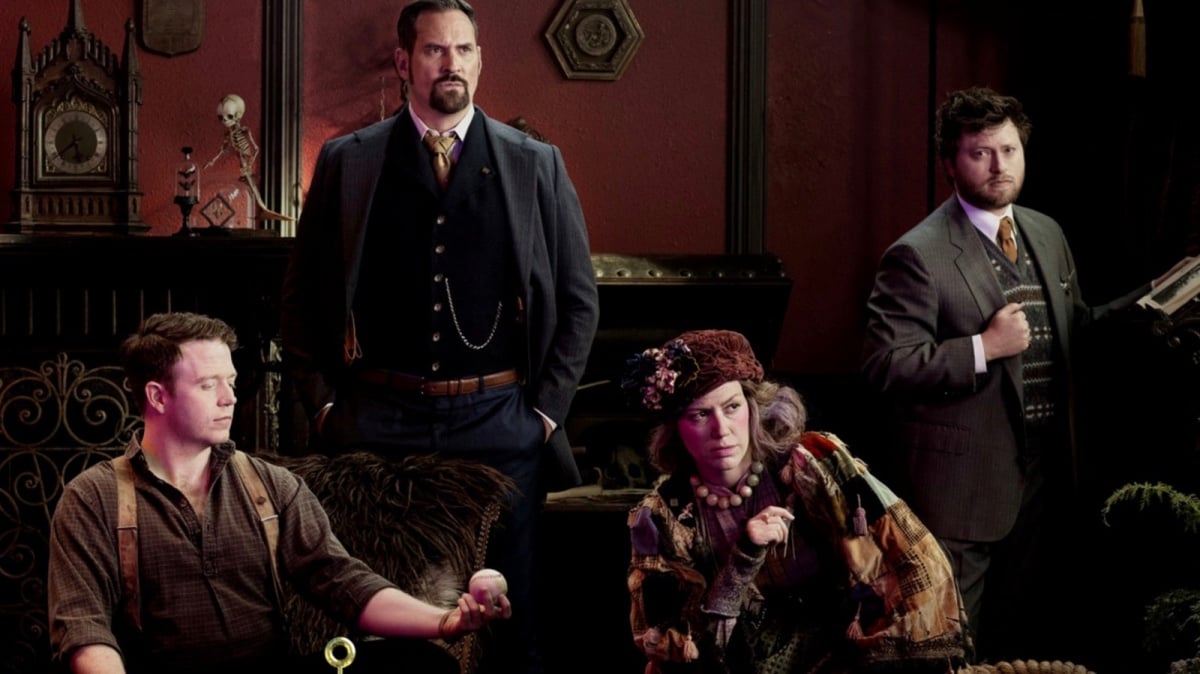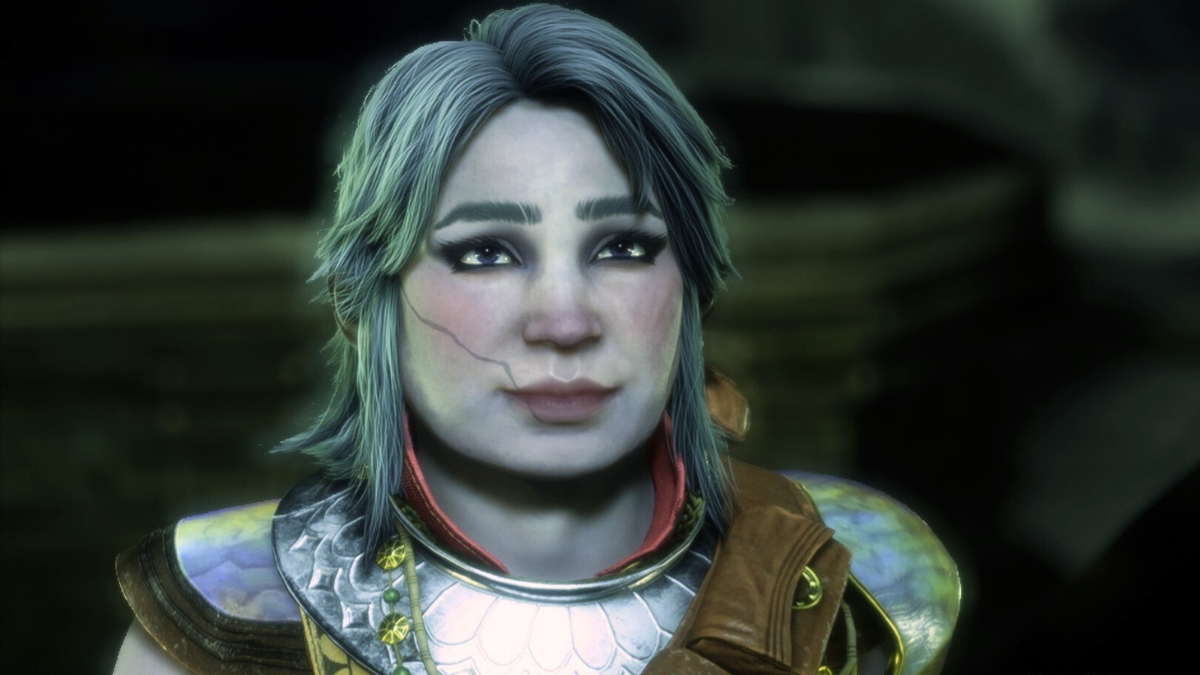Last Month, Critical Role premiered the second installment of its eldritch horror limited actual play series, Candela Obscura, with the first chapter of the new story, “Eye for An Eye” premiering in theatres in addition to the Twitch and YouTube release. Not only does season two of Candela Obscura feature an entirely new cast of characters (known as the Circle of Needle and Thread), but a new GM, as well.
In place of Matt Mercer at the head of the table is Spenser Starke, a longtime game designer for Critical Role’s Darrington Press and one of the minds behind the Candela Obscura game system of the same name. The Circle of Needle and Thread has already carved an identity for itself as darker, rawer glimpse into the world of Newfaire—thanks in part not just to the stellar cast, but the careful guidance and leadership of Starke as GM. Ahead of the recent episode two premiere, The Mary Sue had the opportunity to virtually talk with Starke about Candela, what it’s like filling Mercer-shaped shoes, and what cans expect from the upcoming final chapter.
Q: Having your first time formally GMing on a stage as large as Critical Role’s is definitely a trial by fire. What were your biggest anxieties/stress points heading into this campaign?
A: Yeah, I can’t lie, I was absolutely terrified. I’ve been GMing for a long time, and I’ve played with everyone at the table but Zehra before, but previous to this I’ve really been more of a home game GM – I ran a lot of Candela Obscura games for Travis and Marisha during its development, so when it came time to follow Matt in Chapter 2, they very kindly asked me to jump in. My biggest anxiety was letting the community down if my work didn’t live up to the kind of storytelling they are used to on the channel. I also have a specific style to running games and I knew that some people would (hopefully) like it and others probably wouldn’t, but that’s just the reality of putting yourself out there! Luckily, the reaction has been very positive, so I’m incredibly thankful and relieved. I just wanted to make the creative team here proud.
Q: You’re in the incredibly unique position of being not just the GM, but the creator and writer of the system you’re running the campaign with. How did the experience of creating Candela’s mechanics from the ground up impact your approach to GM’ing?
A: I think that the main way it’s impacted me is that I have run the game A LOT. So I know where the system can really help the storytelling and where to let it fall away. One major thing I watched people react to on episode one was how often I was giving out marks to the players. We talked about what we wanted out of this season, and everyone agreed we really wanted to lean into the horror and the danger for this chapter. So knowing the way the system works and also knowing we only have three episodes to tell a story, I purposefully ramped up how marks were given out to get us there. It’s a horror story, so nobody and nothing is safe by the end of our journey.
Q: On the other side of that coin—now that you also have experience as a GM, is there anything from this experience that you’ll be implementing when you develop game systems in the future?
A: As a designer, most of my job is GMing games and evaluating how they went, they just aren’t usually in front of a camera for a large audience! But I try to build the games I make to be as accessible as possible for players of all experience levels. I think that’s my biggest tip for people who want to make games that are easily streamable; even if they have some crunch on them, create tools and guides for the people at the table to reference so they aren’t flipping through pages of a rulebook to get an answer.
Q: Candela chapter 2 features Critical Role regulars, familiar guest stars, and entirely new faces. How did you go about putting this cast together?
A: That was all the production team, so shout out to them! They gave me a cast list and I had zero notes.
Q: Candela Obscura has a very specific, Lovecraftian sort of flare. Were there any specific works of art, literature, etc that inspired you during the process of creating the game?
A: Mike Flanagan and Ari Aster are my two largest points of inspiration in the horror genre, so I really wanted to bring that style of storytelling to our games. Because of the nature of the characters, I also knew this would be a very different tone than season one; we had a table that was so centered around the war, I wanted to lean into giving them some of that “action horror” genre as well. For that side of things, 1917 directed by Sam Mendes was a massive inspiration.
Q: Your GM style makes frequent use of “shots,” and leans heavily into the cinematic elements of storytelling. How did you develop your GM style, and was it always your intention to describe scenes like parts of a film?
A: I come from a background in screenwriting and directing, so when I first started GMing for my friends, I was mostly telling stories with other writers, directors, actors, and producers. Our shared language was cinema, so that was just how we communicated our vision of the scene to each other. It wasn’t until playing with other groups that I even realized it was something that I did! But it’s just how I run my games now, and I’ve found that it lets me describe what I’m seeing in my head visually to players in a way that helps us all to have a shared vision of the scene.
Q: One interesting facet of the Candela system is the “mixed success” mechanic. When a player rolls a mixed success, how do you go about determining the nature of that success?
A: Mixed successes have a long history in narrative forward RPGs, so I take a lot of guidance from the Powered by the Apocalypse and Forged in the Dark games that have come before my time with Candela. But tone and narrative usually play the most important parts in deciding the consequences for me. For example, this season we are running a very intense psychological and action-oriented game, which means I’m much more liberal and heavy-handed with my consequences and with my GM moves overall than I would be in a heroic-style game. As a table, we wanted the threat of death on the board at all times, which means as a GM, my responsibility is to put them in dangerous situations and show them the consequences, while also offering them a hard way out that they could fight for.
Q: I really enjoyed your use of sound effects and lighting, especially in Sean’s flashback sequences. What’s your approach to determining when/where shifts in lighting and sound are appropriate?
A: I had the war flashback lighting/sound sequence built because after the session zero, I knew we’d be dealing with those memories coming back to haunt the circle. That was our one big unique piece for the season. Everything else was just feeling in the moment! Especially during individual scenes, being able to turn the lights down on everyone except for the one or two people who are interacting between assignments was really empowering, and I think also let the players have moments where they knew they didn’t have to be “on.” They could sit back and watch, and that’s so important as a table of storytellers. The more invested we can be in each other’s stories, the better ours become.
Q: With a cast as talented as this one, I could easily get lost in the roleplay and let scenes go on for ages. How do you decide when/where to pace cuts between scenes?
A: I try to cut into a scene where things become the most interesting and cut out of a scene after we’ve found the conclusion. I think about episodes in five act structure, but I also think about scenes that way. I’m not always successful at it, but I try to listen to the table and gauge when they are feeling ready to move on. And then, if I can find a good button to go out on, I seize that opportunity to cut away. A lot of times, someone says something that, in a movie, you’d cut away on at the end of a scene, so I listen for that and do my best to make the call. But I always tell players that if we need to rewind we always can—I’m the guide, not the god.
Q: I’m curious about your specific approach to gaming in Candela as opposed to some of the other systems you’ve worked on like Kids on Brooms or Icarus. What are elements you consider most interesting/useful to highlight when it comes to character builds and strategy in Candela?
A: Candela is the most mechanically-complex game I’ve ever had published, but I do believe the same principles hold true for me—build the kind of character you are most interested in, and let the mechanics support that. If they don’t, change the mechanics. Travis, for example, wanted to have a different “mode” he switched into when he went full lieutenant, so I built him a custom way to swap between his journalist sheet (his new life) and his detective sheet (his old life). I also encourage the players to change their Illumination Keys if they don’t work for the kind of character they want to play. I think customizing the game for your needs and your players is really important!
Q: Candela chapter two takes place before chapter one. How/why did you decide that the Circle of Needle and Thread’s story should happen before Vassal & Veil?
A: It’s interesting that people have made the assumption that it takes place before the first season, because we explicitly didn’t call out where it lies in the timeline! I think because the war is so deeply involved, it brings people back to the time when that was happening, but we are not placing it anywhere in relation to the Vassal & Veil just yet.
Q: Sticking with the theme of timeline, the late Victorian/early Edwardian era is a key element of Candela’s aesthetic trappings. What are your thoughts on Candela taking place in different time periods/locations? Would the organization even exist in the present day?
A: I think it absolutely exists in other time periods and locations, this was just where in space and time we placed our focus for the moment. I am very interested in what Candela was like during the fall of Oldfaire, as well as what Candela might look like now. There is so much to explore, and I hope, in success, we get to do that!
Q: If you could give a one-word hint regarding Candela’s third and final episode, what would it be?
A: The single-word hint that I would give for the final episode is: sacrifice.
(featured image: Critical Role)









Published: Oct 10, 2023 03:47 pm